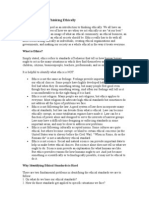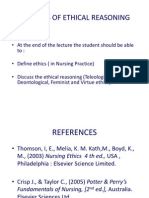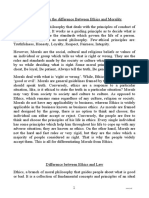Ethical Issues and Case Studies: Computer Ethics
Ethical Issues and Case Studies: Computer Ethics
Uploaded by
Chipu ChonkiCopyright:
Available Formats
Ethical Issues and Case Studies: Computer Ethics
Ethical Issues and Case Studies: Computer Ethics
Uploaded by
Chipu ChonkiOriginal Title
Copyright
Available Formats
Share this document
Did you find this document useful?
Is this content inappropriate?
Copyright:
Available Formats
Ethical Issues and Case Studies: Computer Ethics
Ethical Issues and Case Studies: Computer Ethics
Uploaded by
Chipu ChonkiCopyright:
Available Formats
Computer Ethics
Ethical Issues and Case Studies
Case studies are a standard method of teaching for philosophy, law, and to a lesser extent, the social sciences. A computer ethics case study is a specific story, usually based on true events, which presents an ethical dilemma. Dilemmas are problems which do not have solutions based in facts; rather they call upon principles, general rules of morality and ethics which guide actions. Philosophical ethics is the study of these principles.
The goal of philosophical ethics is not finding correct solutions, it is identifying clear thinking and the implications of clear thinking for behavior. Clear thinking is a meta-skill, a skill that applies to almost all other skills. Like other skills, clear thinking requires learning, practice, discipline, and direct experience. We learn clear thinking when faced with relevant personal decisions that do not have clean answers but do have direct consequences. The objective of philosophical debate is not to change a persons mind, rather it is to identify the assumptions underlying a position and the quality of thought which supports that position. You may already have noticed that discussions of philosophical ethics are branchy, the ideas lead quickly from one to another and it is easy to lose the focus of conversation. One role of the case study is to help focus discussion. Philosophical ethics is also deep, answers and intentions are difficult to identify, often requiring extensive analysis, self-observation, and argumentation. For these reasons, this class will enforce some ground rules for group discussion and for written assignments and commentary.
Ground Rules for Discussion of Computer Ethics 1. The reasoning which leads to an opinion is important, not the opinion itself. 2. When discussing a case study, do not change the circumstances or the story of the study. 3. Apply structured techniques to formulate and clarify thinking. 4. Identify the ethical component of an issue (what part of a dilemma requires an ethical approach?) 5. Identify the Computer Science component of an issue (what part of the ethical component is unique to Computer Science?) 6. Distinguish between positive arguments (do this) and negative arguments (dont do this). 7. Distinguish between personal and professional ethical positions. 8. Distinguish between the requirements of logic, of law, of institutional policy, of personal preference, of social convention, and of ethics.
Computer Ethics
Philosophical
Systems
A philosophical system is a consistent set of values and criteria that apply to a wide variety of issues. We have examined four systems:
Idealism
Reality is basically spirit or idea. Knowledge is gained through the mind. Value is measured by conformity to ideals.
Realism
Reality is basically matter or the physical universe. Knowledge is gained through the senses. Value is measured through conformity to nature.
Pragmatism
Reality is process or experience. Knowledge is gained through trial and error. Value is measured by what is of practical benefit to society.
Existentialism
Reality is self-defined. Knowledge is gained through personal decision making. Value is measured by responsible individual choice.
Ethical
Systems
An ethical system is a consistent set of beliefs which can be applied to a wide variety of ethical dilemmas. Some widely argued systems include:
Virtue
Ethical behavior is that which develops moral virtues. Focus on attitudes, intentions, and character traits which enable humans to develop their potential.
Utilitarian
(Bentham,
Mill)
Ethical choices produce the greatest good and the least harm. Focus on consequences of actions.
Human
Rights
(Kant)
Human rights are interests and activities which we must respect and protect as a civilization. Every person has the fundamental right to be respected and to be treated as
Computer Ethics
a free and equal rational agent. This implies other rights, such as privacy, truth, and freedom from harm. Focus on actions which do not use people as instruments toward a goal.
Fairness/Justice
(Aristotle)
Treat people consistently the same, unless there are morally relevant differences between them. Focus on fairness and consistency of actions to distribute benefits and burdens among all members of a group.
Common Good (Plato, Aristotle, Cicero)
Society is a community joined in a shared pursuit of common goals. The good of the individual is inextricably bound to the good of the group. Ethics advances the common good.
Some Techniques of Ethical Analysis Ethical analysis tries to identify the participating parties, their respective stakes and responsibilities, and the essential issues. After this groundwork is in place, various ethical guidelines (rules of conduct) and principles (philosophical systems) are applied to the problem. Most discussion revolves around understanding the intent of the guidelines and principles when applied to a particular case. When addressing an ethical dilemma or a case study, try to answer these questions: 1. What is the ethical issue? Is something morally wrong? Is the issue deeper than personal or institutional concerns? 2. Who are the involvced parties (the people and the organizations affected)? Who has an important stake in resolving the issue? 3. What are the obligations between the parties? Fidelity Reparation Gratitude Justice Beneficence Non-injury (a promise or a contract) (making up for a wrong) (thanking for a right) (comparative merit) (helping a deserving person) (avoiding harm)
4. What would each party consider to be the preferred course of action? 5. Generate several courses of action (at least three, two extremes and a compromise). Identify broad filters which might constrain the choice of options for action. 6. For any choice of action, determine the impact on each of the parties:
Computer Ethics
a. Are any ethical guidelines violated? b. What are the best-case and worst-case outcomes? Are they tolerable? c. What benefits and harm will be caused? Does the good outweigh the possible harm? d. Are there rules or principles which invalidate a choice of actions? e. List the consequences, risks, and costs. 7. Choose a course of action, and identify which philosophical system it aligns with: Ethical egoism Utilitarianism Human Rights Ethical Relativism Fairness and social justice Common good 8. Which alternative actions produce the best overall consequences? Which respect the moral rights and dignity of all parties? Which treat people fairly, without favoritism or discrimination? Which advance the common good? Which develop moral values? Which recognize the cultural context? Which are the most consistent? 9. Do different ethical systems generate different courses of action? Are there issues to which none of the ethical systems apply? Which system is most compelling for resolving the particular issue? 10. Finally make a clear and definitive decision about a course of action. Suggest policy changes which will prevent the problem from recurring.
Summary 1. 2. 3. 4. 5. 6. 7.
of
Ethical
Analysis
Specify the FACTS. Define the DILEMMA. Identify the PARTIES and their interests. Clarify the VALUES and PRINCIPLES at stake. Formulate the possible ACTIONS. Identify the potential CONSEQUENCES. Make a clear DECISION.
You might also like
- Ethical Issues and Case Studies: Computer EthicsDocument4 pagesEthical Issues and Case Studies: Computer EthicsJAMESJANUSGENIUS5678No ratings yet
- Hyundai Ethical Case StudyDocument10 pagesHyundai Ethical Case StudyAnuj SharmaNo ratings yet
- Explain The Difference Between Intrinsic and Instrumental ValuesDocument2 pagesExplain The Difference Between Intrinsic and Instrumental ValuesJm B. VillarNo ratings yet
- A Framework For Ethical Decision MakingDocument15 pagesA Framework For Ethical Decision MakingNarendra KumarNo ratings yet
- A Framework For Thinking EthicallyDocument4 pagesA Framework For Thinking EthicallyYashaswiPathakNo ratings yet
- Ethical N Critical Decision MakingDocument9 pagesEthical N Critical Decision Makingvks4585No ratings yet
- Christian Ethics 4 Final Paper Aug 24Document4 pagesChristian Ethics 4 Final Paper Aug 24RinielNo ratings yet
- Ethics FrameworkDocument4 pagesEthics FrameworkNikhil JoshiNo ratings yet
- A Framework For Ethical Decision Making in The Business WorldDocument8 pagesA Framework For Ethical Decision Making in The Business Worldale802No ratings yet
- How To Think and Act Ethically Ethical FrameworkDocument5 pagesHow To Think and Act Ethically Ethical Frameworksureshml1710pNo ratings yet
- A Framework For Ethical Decision MakingDocument4 pagesA Framework For Ethical Decision MakingShiella Mae GrantosNo ratings yet
- Ethical Behavior: Step 1-LearnDocument10 pagesEthical Behavior: Step 1-Learnprince husainNo ratings yet
- The New Challenges: The Challenge of Ethical BehaviourDocument63 pagesThe New Challenges: The Challenge of Ethical BehaviourPrakhar RanjanNo ratings yet
- 2.2 Decision Making - A Framework For Thinking EthicallyDocument4 pages2.2 Decision Making - A Framework For Thinking Ethicallywiwid permamaNo ratings yet
- Ethical Business FrameworkDocument7 pagesEthical Business FrameworkWarisha LodhiNo ratings yet
- Ch03-Ethics and Ethical AnalysisDocument25 pagesCh03-Ethics and Ethical AnalysisEng. Abdullahi NuxurNo ratings yet
- Article Two of TwoDocument4 pagesArticle Two of TworailamutukaNo ratings yet
- A Framework For Ethical Decision Making: What Is Ethics?Document4 pagesA Framework For Ethical Decision Making: What Is Ethics?Patriot NJROTCNo ratings yet
- Framework On Thinking EthicallyDocument3 pagesFramework On Thinking EthicallyLabingla VingyuuuNo ratings yet
- Busines EthicsDocument63 pagesBusines EthicsHanzla RahmanNo ratings yet
- Ethics & Governance: Drjlgupta MdiDocument82 pagesEthics & Governance: Drjlgupta MdiAman PratikNo ratings yet
- Boundless Business: A Brief Definition of Business EthicsDocument15 pagesBoundless Business: A Brief Definition of Business Ethicsdestiny_of_ariesNo ratings yet
- Unit 1Document23 pagesUnit 1Bhavesh PasrichaNo ratings yet
- Module 2 ReviewerDocument8 pagesModule 2 ReviewerElmeerajh JudavarNo ratings yet
- 1 - A Framework For Thinking EthicallyDocument6 pages1 - A Framework For Thinking EthicallyAlejandraLimasNo ratings yet
- Ethics PDFDocument13 pagesEthics PDFRick StantonNo ratings yet
- ENGR 201 Quiz 2 NotesDocument22 pagesENGR 201 Quiz 2 NotesHimangshu BaruahNo ratings yet
- A Framework For Thinking EthicallyDocument3 pagesA Framework For Thinking Ethicallyfarhan sultanNo ratings yet
- IT 302 - An Overview of Ethics - DeBelenMenirissaDocument26 pagesIT 302 - An Overview of Ethics - DeBelenMenirissaJay-B Salamat EnriquezNo ratings yet
- 3 Ethical Decision MakingDocument5 pages3 Ethical Decision MakingMohan Kumar Jadhav100% (1)
- ETHICS 101 IntroDocument23 pagesETHICS 101 IntroSaito HiragaNo ratings yet
- Activity: "What Does Ethics Mean To You?" Agree Partially Agree Totally Agree Disagree Partially Disagree Totally DisagreeDocument72 pagesActivity: "What Does Ethics Mean To You?" Agree Partially Agree Totally Agree Disagree Partially Disagree Totally DisagreeGiddel NaragNo ratings yet
- Setting A Moral Vision For Academe: Bridging The "Is-Ought" Divide in International EducationDocument19 pagesSetting A Moral Vision For Academe: Bridging The "Is-Ought" Divide in International EducationdesioktarianaNo ratings yet
- Chap 2 (Ethical Theories +application) Business Ethics - Methods and ApplicationDocument31 pagesChap 2 (Ethical Theories +application) Business Ethics - Methods and ApplicationMirha KazamNo ratings yet
- Theories of Ethical ReasoningDocument43 pagesTheories of Ethical ReasoningJSeasharkNo ratings yet
- Business Ethics Ch2Document7 pagesBusiness Ethics Ch2Dina OmerNo ratings yet
- BE Chapter 2Document10 pagesBE Chapter 2damenegasa21No ratings yet
- Business Ethics Ch2Document9 pagesBusiness Ethics Ch2yosefmechal21No ratings yet
- Thinking EthicallyDocument14 pagesThinking EthicallyAnonymous qAegy6GNo ratings yet
- Ethics - AspireiasDocument31 pagesEthics - AspireiasstrshirdiNo ratings yet
- 11.summary Sheet EthicsDocument46 pages11.summary Sheet EthicssuvidjainNo ratings yet
- Discuss The Scope of Engineering Ethics With ExampleDocument14 pagesDiscuss The Scope of Engineering Ethics With ExampleSAR_SuvroNo ratings yet
- Ethics: The Study of What Is Morally Right and WrongDocument22 pagesEthics: The Study of What Is Morally Right and WrongLyka AcevedaNo ratings yet
- Edutap EthicsDocument73 pagesEdutap EthicsRiya Sachdev100% (1)
- Business EthicsDocument102 pagesBusiness Ethicsమధు సూదన రావు100% (6)
- Module 1-2 Ethical Consideration and Moral TheoriesDocument9 pagesModule 1-2 Ethical Consideration and Moral TheoriesJoseph Cayetano MuñezNo ratings yet
- Business Ethics - Doc Answer SheetDocument23 pagesBusiness Ethics - Doc Answer SheetSujit Raj Gourav100% (1)
- ETHC303 Full SummaryDocument25 pagesETHC303 Full SummaryarinNo ratings yet
- EthicsDocument25 pagesEthicsJuliusNo ratings yet
- Introduction To Ethics: CE 421 - Civil Engineering Laws, Ethics and ContractsDocument18 pagesIntroduction To Ethics: CE 421 - Civil Engineering Laws, Ethics and ContractsVICTORIA OMEGA JARAMILLA100% (1)
- Quiz of ManagementDocument6 pagesQuiz of Managementnaveed abbasNo ratings yet
- Ethics Mini Project 2014Document32 pagesEthics Mini Project 2014Abienash ThangavelNo ratings yet
- Lecture 2Document30 pagesLecture 2Anindya CostaNo ratings yet
- Profethics1 171221064010Document51 pagesProfethics1 171221064010Saif Ar-ManNo ratings yet
- Ethical Decision MakingDocument5 pagesEthical Decision MakingRan TejNo ratings yet
- Decoding Right from Wrong: 7 Key Strategies for Ethical Decision-MakingFrom EverandDecoding Right from Wrong: 7 Key Strategies for Ethical Decision-MakingNo ratings yet
- 31 May Erjhjejrjerjkkjerjjkel Jertkerkjk JkerkekkeDocument1 page31 May Erjhjejrjerjkkjerjjkel Jertkerkjk JkerkekkeChipu ChonkiNo ratings yet
- Timeline YOYODocument2 pagesTimeline YOYOChipu ChonkiNo ratings yet
- 2) "NAFTA Has Curbed The Illegal Immigration of Mexicans To USA and Canada". Critically CommentDocument1 page2) "NAFTA Has Curbed The Illegal Immigration of Mexicans To USA and Canada". Critically CommentChipu ChonkiNo ratings yet
- Timeline YOYODocument2 pagesTimeline YOYOChipu ChonkiNo ratings yet






























































